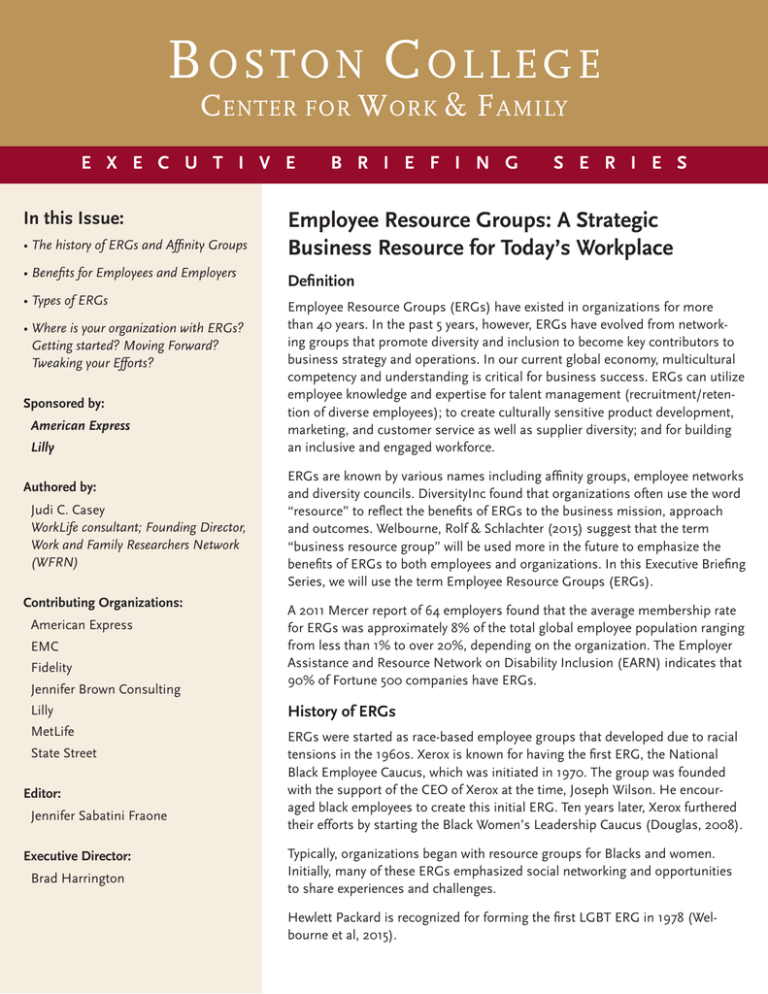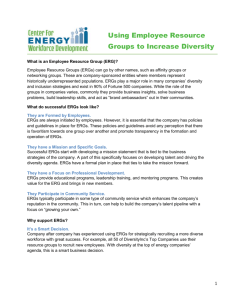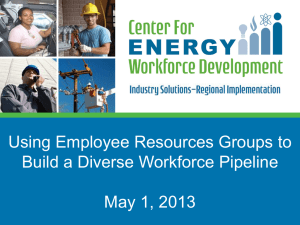B C OSTON OLLEGE
advertisement

B OS TO N C O LLE G E C ENTER FOR W ORK & F AMILY E X E C U T I V E In this Issue: • The history of ERGs and Affinity Groups • Benefits for Employees and Employers • Types of ERGs • Where is your organization with ERGs? Getting started? Moving Forward? Tweaking your Efforts? Sponsored by: American Express Lilly Authored by: Judi C. Casey WorkLife consultant; Founding Director, Work and Family Researchers Network (WFRN) Contributing Organizations: American Express EMC Fidelity Jennifer Brown Consulting B R I E F I N G S E R I E S Employee Resource Groups: A Strategic Business Resource for Today’s Workplace Definition Employee Resource Groups (ERGs) have existed in organizations for more than 40 years. In the past 5 years, however, ERGs have evolved from networking groups that promote diversity and inclusion to become key contributors to business strategy and operations. In our current global economy, multicultural competency and understanding is critical for business success. ERGs can utilize employee knowledge and expertise for talent management (recruitment/retention of diverse employees); to create culturally sensitive product development, marketing, and customer service as well as supplier diversity; and for building an inclusive and engaged workforce. ERGs are known by various names including affinity groups, employee networks and diversity councils. DiversityInc found that organizations often use the word “resource” to reflect the benefits of ERGs to the business mission, approach and outcomes. Welbourne, Rolf & Schlachter (2015) suggest that the term “business resource group” will be used more in the future to emphasize the benefits of ERGs to both employees and organizations. In this Executive Briefing Series, we will use the term Employee Resource Groups (ERGs). A 2011 Mercer report of 64 employers found that the average membership rate for ERGs was approximately 8% of the total global employee population ranging from less than 1% to over 20%, depending on the organization. The Employer Assistance and Resource Network on Disability Inclusion (EARN) indicates that 90% of Fortune 500 companies have ERGs. Lilly History of ERGs MetLife ERGs were started as race-based employee groups that developed due to racial tensions in the 1960s. Xerox is known for having the first ERG, the National Black Employee Caucus, which was initiated in 1970. The group was founded with the support of the CEO of Xerox at the time, Joseph Wilson. He encouraged black employees to create this initial ERG. Ten years later, Xerox furthered their efforts by starting the Black Women’s Leadership Caucus (Douglas, 2008). State Street Editor: Jennifer Sabatini Fraone Executive Director: Brad Harrington Typically, organizations began with resource groups for Blacks and women. Initially, many of these ERGs emphasized social networking and opportunities to share experiences and challenges. Hewlett Packard is recognized for forming the first LGBT ERG in 1978 (Welbourne et al, 2015). What do ERGs do? ERGs generally develop their own agenda and determine their mission and goals. They educate the organization about the ERG’s mission so that their efforts are visible within the organization and get interested others involved. Often, ERGs are staffed by employees who volunteer their time. In some cases, however, members can be elected to participate or leaders may be nominated by their supervisors. ERGs can host events, assist with recruitment and engagement plans, serve as advisors for business activities and decisions, advocate for social change, and get involved in community service. Meetings are held at intervals determined by the members. Some groups receive financial support from their organizations to assist with activities, materials or events. The Mercer report (2011) found that budgets vary greatly between “$150 for every 100 members to over $37,000” with an “average of $7,023 per every 100 members.” DiversityInc reports a yearly average of $15,000 for the ERGs represented by the organizations in the DiversityInc Top 50. Types of ERGs There are numerous types of ERGs at different organizations. ERGs are typically organized by a “demographic (e.g. women), life stage (e.g. Generation Y), or function (e.g. sales).” One way to frame the types of ERGs is to view them as falling into one of 3 categories: “social-cause centered, professional-centered and attribute-centered“ (Welbourne et al, 2015). The most popular ERGs are focused on women and LGBT employees (Douglas, 2008). The Mercer report (2011) found that women, race/ethnicity and LGBT are the most commonly created ERGs. The ERGs with the most traction and interest tend to be those ERGs that are closely linked to business strategy. When employees perceive their efforts to as directly impacting business outcomes, they are more likely to get involved (Mercer, 2011). Below are some of the most popular types of ERGs (Diversity Best Practices, 2011): • Caregiver (dual earner parents, single parents, adoptive parents, elder caregivers, health-related, disability etc.) • Cultural diversity and/or geographic area • Employee alumni • Flexible/Remote workers • Generational (e.g. older workers) and early career employees • LGBT employees • Men and dads at the workplace • People with disabilities (nearly half of employers have this type of ERG) • Religious affiliations • Veterans • Women in the workplace including leadership development groups/training LILLY Lilly offers 10 employee-led resource groups with about 60 regional affiliate groups globally that connect people from diverse backgrounds and, at the same time, support Lilly’s business objectives. These include the: African American Network (AAN), Chinese Culture Network (CCN), Lilly India Network (LIN), Africa, Middle Eastern and Central Asia Network at Lilly (AMECA), Early Career Professionals (ECP), Organization of Latinos at Lilly (OLA), People Respecting Individual Differences Equally (PRIDE), Global Women’s Network (WN), Working and Living With Disabilities (WLD), and Veterans Leadership Network (VLN). About 12,500 employees are members of or have participated in these ERGs. Active ERG members gave approximately 12,500 hours in 2015 to help Lilly’s business internally and devoted 8,000 hours externally. Employee Resource Groups are key leaders in driving diversity and inclusion strategy across the company. Although some emphasis is placed on networking and educational opportunities for members, much time is devoted to advancing critical workplace and marketplace objectives. -2- Benefits of ERGs for Employees and Employers ERGs provide a unique opportunity for creating a more effective talent management approach in addition to an informed and consumer-sensitive business strategy. •C ulture of Diversity and Inclusion achieved from the work of individual ERGs and the synergy of ERGs working together There are numerous benefits of ERGs for employees and employers. •C ulturally Sensitive Marketing and Product Development created with input from employees with expertise in specific demographics or regions •C onnections and Networking offered with “like others,” with employees at all levels, and with leaders and decision makers • Customer Retention boosted from hiring diverse employees who create culturally sensitive marketing and products • Innovation promoted by creating opportunities for diverse and culturally sensitive ideas to develop, and informed decision making with input from employees knowledgeable about specific demographics or populations •C ommunity Brand enhanced by increasing visibility in the community as a diverse and inclusive employer represented by employees who work to benefit the community • L eadership Development and Career Promotion Opportunities provided for employees at all levels “Consider these two questions as you and your organization make the commitment to enable your ERG into a powerful advancement platform where talent and business development interconnect and build upon one another: • Mentoring Opportunities given from the top-down and bottom-up (e.g. younger employees mentoring senior leaders on social media) •T alent Acquisition, Talent Management and Recruitment efforts expanded to include a diverse employee base through the connections and networks of ERG members 1. How can your ERG better influence corporate growth and unlock opportunities for business by giving its members a voice? 2. How can your ERG be more strategic about how to positively impact the recruitment, engagement and building of a workplace culture that is most favorable to the changing face of America and that represents the fastest growing workforce communities?” •P rofessional and Personal Development Opportunities surface through involvement with and visibility within ERGs •E ngagement, Commitment, Retention and Job Satisfaction strengthened by offering employees a voice in decision making as a direct contributor to the business outcomes of the organization (Forbes, 2012) AMERICAN EXPRESS Launched in 2005, Parents at Amex reaches more than 5,000 members across eight chapters globally. The network drives a culture of awareness and support through initiatives that help families manage their priorities, both personal and professional. Initiatives range from new parent chats, special needs support groups, fatherhood breakfast series, summer camp fairs and parent appreciation days, to name a few. Additionally, through the annual Parents at Amex leadership conferences, chapters around the world have partnered together to understand the needs of its members and their families. Chapters have collaborated on a global newsletter, as well as a special recognition for families through the global “Working Parent and Caregiver of the Year” awards. American Express’ inclusive culture means employees are engaged and encouraged to create innovative programs that support employees and their families as they find a work-life fit that’s right for them. -3- WHERE IS YOUR ORGANIZATION ON THE ERG JOURNEY? Getting started with ERGs Perhaps your organization is just getting started with ERGs. Here’s how you might begin: levels within the organization, leadership opportunities, mentoring possibilities). Include not only employees that reflect that demographic or characteristic, but also employees interested in learning more about a particular population, topic or area. • Formalize: Consider creating a document that details the role of ERGs in your organization and how they can impact recruitment/retention, organizational culture and business outcomes. Will a formal governance process be established with a defined structure? Has employee input been solicited and utilized? •D evelop Leadership: Determine how you will recruit executive sponsors and provide mentoring/leadership opportunities. What skills/values and attributes will be needed for these positions? Will Diversity & Inclusion staff coordinate ERGs efforts? •M ake the Business Case: Describe and articulate the value proposition/business case of your organization’s ERGs. What are the mission and the goals? Capitalize on existing efforts that are aligned with the work of your ERGs. • Communicate: Determine how the voices/data from the ERGs will be shared with executives/leaders and other members of the organization to provide diverse and informed opinions that can drive business decisions. • Customize: Start with the ERGs that align with your business needs. Don’t worry what your competitors are doing. • Assess Outcomes: Figure out how you will measure success. How have ERGs impacted the business? Are employees who participate more engaged, satisfied or promoted? Have your efforts been linked with recruitment strategies? What have been the business outcomes? •G et Members: Recruit employees from various areas of the organization and articulate the benefits of participating in ERGs (interacting with employees from all Moving forward with ERGS Perhaps your organization has ERGs that have been in place for a number of years. Here are some ways to maintain momentum. • Benchmark: Now is the time to learn what your competitors are doing. Is there something to be learned from their approach? • Consider New ERGs: Explore whether new ERGs can be created to reflect changing business needs and employee interests. Is the organization responsive to requests for new groups? •A ssess Impact: Are management practices aligned with the efforts of the ERGs? Has the opportunity to leverage ERGs’ voices and data been optimized? What new strategies or alliances have been implemented as a result of ERGs? Could this be improved? If so, how? •U pdate Formal Structure: Does the initial organizing document need to be re-written to reflect changing priorities or lessons learned? Has employee input been solicited? Do group leaders meet regularly with senior executives and/or the CEO? • Measure Success: How do you stand up to your measures of success? What could be improved? Should new measures be added? • Assess Membership: Does ERG membership include employees at all levels of the organization? If appropriate, is the group cross-cultural? Are you actively marketing your ERGs to employees? Do involved employees feel that their contributions/time are valued by supervisors and the organization? “Employee Resource Groups are no longer just social networks but are groups of individuals that strategically impact business. LIN and its members strive to expand market reach, contribute to business goals and increase employee engagement by promoting cultural awareness •N eed Sponsors?: Do ERGs have executive sponsors? Have there been opportunities for mentoring and leadership? Do sponsors receive any training to ensure that they have the skills to be effective? Have the ERGs collaborated effectively? and finding rewarding development opportunities.” Sudhakar Chintharlapalli, Lilly India Network Chair -4- Tweaking your ERGs •A ssess Synergy: Are ERGs working with each other to promote synergy of efforts? Perhaps your organization has a full menu of ERGs. How can you tweak your existing ERGs to solidify success? •E valuate Culture: Do your ERGs help to create an engaged and inclusive culture? Do employees feel that their contributions are valued and making a difference? • Create Accountability: Are managers held accountable for results in their ERGs? Are outcomes tied to compensation and/or an aspect of the performance review? • Enhance Coordination: Are your ERGs partnering with HR and other Talent Management leaders? Business units? •G et Employee Input: Have you surveyed employees to learn their views on your current ERGs? If employees are not involved, what are the barriers? If an ERG member, what are the benefits of involvement? •C ontinue to Measure: Make sure that the ERGs are continuing to operate successfully. Be open to improvements and modifications. Measure at regular intervals. • Communicate: Has your organization communicated both internally and externally how ERGs have impacted business operations, and improved recruitment and retention efforts to create a more diverse, inclusive and engaged organization? Are you maximizing the use of technology and social media for your communication efforts? • Share Success: Inform the community and stakeholders about your success. Partner with external organizations to solidify your position as a leader. “ERGs have long been a safe space in which underrep- EMC resented groups of diverse employees could find support At EMC, diversity and inclusion are embraced as a foundation of the business strategy . With leadership and support from the executive level, EMC is able to drive the global inclusion philosophy throughout the company. Another key component to imbedding diversity and inclusion into EMC is having a robust diversity strategy aligned to the organizational strategy. Global Workforce Inclusion with support from EMC’s Employee Circles work closely with executives and management teams to implement programs and training in a way that best reflects the needs of the company and its diverse global employee base. and networking, but some deliver additional business value more effectively than others. Enter the Executive Sponsor – a senior leader charged with ensuring the group has the organizational capital to make their existence and activities impactful. Engaging Executive Sponsors in an active leadership role vis-à-vis ERGs enables them to be catalysts for specific actions that nurture and develop the ERG, stakeholders and the organization itself. Executive Sponsors EMC is fortunate to have 12 Employee Circles covering various dimensions of diversity - with over 50 Chapters in 12 different countries around the world. are the hinges connecting ERGs with the companies that founded and hope to benefit from them. Given the rate and pace of change, the next decade in diversity will see ERGs evolve into smarter teams of “Our 9000+ employees who are members of the Circles are some of the most engaged and enthusiastic employees in the company. They play an active role in fostering an inclusive culture and support our goal of holding our distinctive position as one of the best places to work in the world.” dedicated leaders whose eyes will be on the return on engagement. These groups and their leaders will play a key role in ensuring companies pivot quickly and effectively to capitalize on global competitive markets and manage the enduring “war on talent.” Danny Best, EMC Director Diversity and Inclusion Jennifer Brown, Founder & CEO Jennifer Brown Consulting -5- Challenges and Potential Solutions Organizations may encounter various challenges in actualizing the full potential of their ERGs. Challenge: ERGs are not well integrated within the organization, limiting their ability to impact business outcomes. Solution: • Develop guidelines and policies that provide transparency about the roles that ERGs can play • Align ERG activities with business strategy via internal and external partners • Look for connections and leverage relationships with existing groups having similar goals (e.g. Diversity and Inclusion, Talent Management) and other ERGs • Ensure that senior leaders are aware and supportive of the goals of ERGs, and encouraged to actively solicit and utilize their input • Communicate ERGs contributions to highlight their value to the organization Executive Sponsors are difficult to engage or not willing to participate. • Link involvement in ERGs with supervisory performance ratings ERGs are viewed as low value and employees do not want to get involved. • Have satisfied employees communicate the benefits of participation to potential interested others (professional development/career growth) • Highlight and communicate Executive Sponsor roles in successful ERGs • Have engaged senior leaders articulate the benefits to their peers of taking part in ERGs • Encourage supervisors and managers to support, promote and reward employee involvement in ERGs • Allow employees to meet on company time and provide space for meetings • Emphasize opportunities for community service, recruiting talent and contributing to innovation with diverse customers ERGs are not effective contributors due to unclear or ineffective mission/goals. • Establish ERGs credibility by articulating how mission/ goals are aligned with business strategy • Create and communicate the strategic plan to achieve business objectives • Identify the unique contributions of the ERG in comparison to other existing ERGs and share best practices • Ensure that management practices are coordinated with ERG efforts The organization doesn’t provide any resources for activities and events. • Prepare a yearly budget to receive funding based on the successes of annual activities • If possible, have the Executive Sponsor advocate for the ERGs financial needs “Parents at Amex has been an invaluable resource as I navigate my career growth at Amex. In addition to providing practical information to parents, the connections I’ve made with other working parents have helped shape my expectations of what’s possible as a working parent and gave me the confidence to take on more responsibility both at work and at home.” Rita S., Parents at Amex New York -6- FIDELITY INVESTMENTS METLIFE At Fidelity Investments, Employee Resource Groups have provided a solid foundation for their Diversity Strategy, and have been instrumental in engaging associates around the importance of creating and fostering an inclusive workplace. For over 30 years, MetLife’s Diversity Business Resource Networks have made an impact on people, customers and communities. In 2012, the company began to grow the networks globally, including the expansion of two of the fastest growing networks, the Women’s Business Network (WBN) and Rising Professionals (iRISE). At the inception of these groups, the focus was primarily networking, providing connections and onboarding. As they have developed over the past several years, the focus has shifted to professional development, mentoring and, more recently, creating business impact. With more than 30 networks around the globe serving thousands of members, WBNs focus on fostering a global community where all women thrive through career development and engagement activities. The networks offer opportunities for members to strengthen their business skills and create support networks and also collaborate with different business areas to identify commercial opportunities. Under the auspices of the WBN, close to 2000 women have registered for Lean In Circles, illustrating the power of peer support to build confidence, empower one another to overcome hurdles and achieve their goals. An example is the LGBTA employee resource group Fidelity Pride. This ERG helped the investor center leadership team create a Same Sex Estate Planning seminar to assist financial representatives in serving their LGBT customers in a more meaningful way. The result was an increase in assets from this underserved customer segment as well as leveraging this educational forum across the country. The veterans group, FiVE, has been instrumental in helping to recruit veterans for a number of hiring initiatives. For example, Fidelity hired 26 veterans for the General Management Apprentice program over the past several years. The FiVE group provided support in helping to attract these hires as well as to onboard them to the organization. iRISE, now located in the U.S., Hong Kong and Russia, focuses on providing professional development sessions, networking connections and leadership skill building for entry to mid-level leaders. iRISE has successfully launched virtual chapters for employees that increased membership to over 2000 associates in the U.S. For virtual members, a mentoring program was developed to support their career growth. Recently, the network led MetLife’s participation in the study How Millennials Navigate Their Careers with the Boston College Center for Work & Family. Fidelity continues to see success in leveraging ERGs for business initiatives, including the Women’s Leadership Group participating in the Women Investors initiative, and the Black and Latino group assisting at career events to help attract top talent. STATE STREET State Street’s Flex Work Employee Network (FWEN) is committed to supporting the adoption, use and acceptance of flex work as a strategic business tool. As the “voice of the employee,” the network influences change and the strategic vision of the company’s Flex Work Program. FWEN’s initiatives include: •F lex Awareness Month - encourages manager support, program awareness and adoption. Through this creative awareness campaign, supported by senior management blogs, webinars and internal social media, FWEN membership increased by 4%. Since the beginning of 2016, formalized flex work arrangements have grown by 17%. • The FlexTech Team- supports business continuity by helping to resolve flex worker’s tech­nical issues that can hinder productivity. • “Help from Home,” a microvolunteering program, gives flex employees the opportunity to volunteer remotely. Volunteers have supported more than 25 projects across a diverse set of nonprofits to date. -7- Conclusions A Publication of the Boston College Center for Work & Family Employee Resource Groups have evolved from employee support networks created to achieve diversity and inclusion to a strategic resources that enhances business outcomes in the following areas: About this Series 1. Involve employees in recruitment and talent management efforts 2. Offer leadership development and mentoring opportunities 3. Capitalize on the knowledge of diverse employees to create consumer sensitive branding and product development 4. Create an engaged and inclusive work environment 5. Promote your organization as an employer of choice and community partner The ultimate goal is for ERGs to be “recognized and valued as (an) integrated business partner to the organization and the community” (Jennifer Brown Consulting, 2015). Written for an executive level audience, the Boston College Center for Work & Family Executive Briefing Series addresses topical and strategic issues of particular relevance to the current business climate. The series highlights research findings, data trends and best practices in a concise format, aiming to foster action-oriented dialogue within organizations. Each issue features an accompanying PowerPoint presentation that captures key points and includes a section for practitioners to customize and add organization-specific data. About this Series Resources DiversityInc, Resource Groups 101: A Primer on Starting Them and Using Them for Business Goals, 2012 Welbourne, Rolf & Schlachter, Employee Resource Groups: An Introduction, Review and Research Agenda, 2015 Mercer, ERGs Come of Age: The Evolution of Employee Resource Groups, 2011 Ask EARN, A Toolkit for Establishing and Maintaining Successful Employee Resource Groups, 2013 Priscilla H. Douglas, Affinity Groups: Catalyst for Effective Organizations, Winter 2008 Forbes, 7 Ways to Enable Your Employee Resource Groups into a Powerful Advancement Platform, 2012 Since its founding in 1990, the Boston College Center for Work & Family (BCCWF) has been a leader in helping organizations create successful workplaces that support and develop healthy and productive employees. We provide a bridge linking the academic community to leaders in employment settings who are committed to promoting workforce effectiveness. With 100 employers as our corporate partners, the Center for Work & Family positively impacts the lives of nearly 4 million employees through research, education and contributing a leading voice to conversations on contemporary issues around work and life. Diversity Best Practices, Top Five Employee Resource Groups for U.S. Workers, 2011 Jennifer Brown Consulting, Executive Sponsors Fuel High-Performing ERGs, 2015 Jennifer Brown Consulting, Employee Resource Groups that Drive Business, 2010 For hyperlinks to the above resources, go to: http://www.bc.edu/centers/cwf/ research/publications.html#executive -8- 22 Stone Avenue Chestnut Hill, MA 02467 Ph: (617) 552-2844 Fax: (617) 552-2859 http://www.bc.edu/cwf







